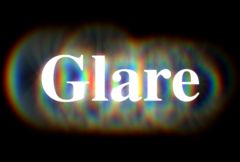S_Glare
Composites rainbow halos and/or glint-like rays at locations where the Source clip is brighter than the threshold. Lower the threshold parameter to produce glares in more areas. Use the Style menu to select different glare types. Set the Glare Res parameter to 1/2 for faster rendering with slightly softer glares. Use the Convolve option for smoother results, but possibly slower rendering. Glares are best observed on dark images with a few bright spots.In the Sapphire Lighting effects submenu.
Inputs:
-
Source: The current layer. The input clip that determines the glare locations and
colors.
- Background: Defaults to None. The clip to combine the glares with. If no background is given, the Source is also used as the Background.
- Matte: Defaults to None. If provided, the source glare colors are scaled by this input. A monochrome matte can be used to choose a subset of Source areas that will generate glares. A color matte can be used to selectively adjust the glare colors in different regions. The matte is applied to the source before the glares are generated so it will not clip the resulting glares.
- Background: Defaults to None. The clip to combine the glares with. If no background is given, the Source is also used as the Background.

|